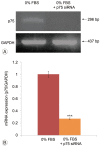Effect of RNA Interference-Mediated Suppression of p75 on the Viability of Rat Notochordal Cells
- PMID: 27994772
- PMCID: PMC5165012
- DOI: 10.4184/asj.2016.10.6.985
Effect of RNA Interference-Mediated Suppression of p75 on the Viability of Rat Notochordal Cells
Abstract
Study design: In vitro cell culture model.
Purpose: To investigate the effects of RNA interference (RNAi) on p75 expression and viability of rat notochordal cells treated with serum deprivation.
Overview of literature: RNAi enables the inhibition of specific genes by sequence-specific gene silencing using a double-stranded RNA.
Methods: Notochordal cells were isolated, cultured, and placed in 10% (control) or 0% (apoptosis-promoting) fetal bovine serum (FBS) for 48 hours. The expression of p75, apoptosis, and cell proliferation were determined. To suppress p75 expression, a small interfering RNA (siRNA) was synthesized against p75 (p75 siRNA) and transfected into cells. The suppression of p75 mRNA expression was investigated using the reverse transcription-polymerase chain reaction. The degree of p75 suppression was semiquantitatively analyzed using densitometry. The effect of p75 siRNA on apoptosis and proliferation of cells was determined. Solutions of an unrelated siRNA and transfection agent alone served as controls.
Results: Serum deprivation significantly increased apoptosis by 40.3%, decreased proliferation of notochordal cells by 45.3% (both, p<0.001), and upregulated p75 expression. The p75 siRNA suppressed p75 expression in cells cultured in 0% FBS. The rate of suppression by p75 siRNA of p75 mRNA was 72.9% (p<0.001). Suppression of p75 expression by p75 siRNA inhibited apoptosis by 7% and increased proliferation by 14% in cells cultured in 0% FBS (both, p<0.05).
Conclusions: siRNA-mediated suppression of p75 inhibited apoptosis and increased proliferation of notochordal cells under conditions of serum deprivation, suggesting that RNAi might serve as a novel therapeutic approach for disc degeneration caused by insufficient viability of disc cells through the suppression of the expression of harmful genes.
Keywords: Notochordal cells; RNA interference; Viability; p75.
Conflict of interest statement
No potential conflict of interest relevant to this article was reported.
Figures







Similar articles
-
Small Interfering RNA-Mediated Suppression of Fas Modulate Apoptosis and Proliferation in Rat Intervertebral Disc Cells.Asian Spine J. 2017 Oct;11(5):686-693. doi: 10.4184/asj.2017.11.5.686. Epub 2017 Oct 11. Asian Spine J. 2017. PMID: 29093776 Free PMC article.
-
Inhibiting the growth of malignant melanoma by blocking the expression of vascular endothelial growth factor using an RNA interference approach.Br J Dermatol. 2005 Oct;153(4):715-24. doi: 10.1111/j.1365-2133.2005.06765.x. Br J Dermatol. 2005. PMID: 16181451
-
Schwann cell apoptosis and p75(NTR) siRNA.Iran J Allergy Asthma Immunol. 2011 Mar;10(1):53-9. Iran J Allergy Asthma Immunol. 2011. PMID: 21358016
-
Effects of lentiviral-mediated Foxp1 and Foxq1 RNAi on the hepatocarcinoma cell.Exp Mol Pathol. 2014 Feb;96(1):1-8. doi: 10.1016/j.yexmp.2013.10.015. Epub 2013 Nov 5. Exp Mol Pathol. 2014. PMID: 24211718
-
Small RNA: can RNA interference be exploited for therapy?Lancet. 2003 Oct 25;362(9393):1401-3. doi: 10.1016/S0140-6736(03)14637-5. Lancet. 2003. PMID: 14585643 Review.
Cited by
-
Small Interfering RNA-Mediated Suppression of Fas Modulate Apoptosis and Proliferation in Rat Intervertebral Disc Cells.Asian Spine J. 2017 Oct;11(5):686-693. doi: 10.4184/asj.2017.11.5.686. Epub 2017 Oct 11. Asian Spine J. 2017. PMID: 29093776 Free PMC article.
References
-
- Park JB, Lee CK, Koh JS, Lee JK, Park EY, Riew KD. Overexpressions of nerve growth factor and its tropomyosin-related kinase A receptor on chordoma cells. Spine (Phila Pa 1976) 2007;32:1969–1973. - PubMed
-
- Rabizadeh S, Oh J, Zhong LT, et al. Induction of apoptosis by the low-affinity NGF receptor. Science. 1993;261:345–348. - PubMed
-
- Frade JM, Barde YA. Nerve growth factor: two receptors, multiple functions. Bioessays. 1998;20:137–145. - PubMed
-
- Friedman WJ, Greene LA. Neurotrophin signaling via Trks and p75. Exp Cell Res. 1999;253:131–142. - PubMed
LinkOut - more resources
Full Text Sources
Other Literature Sources
Research Materials

